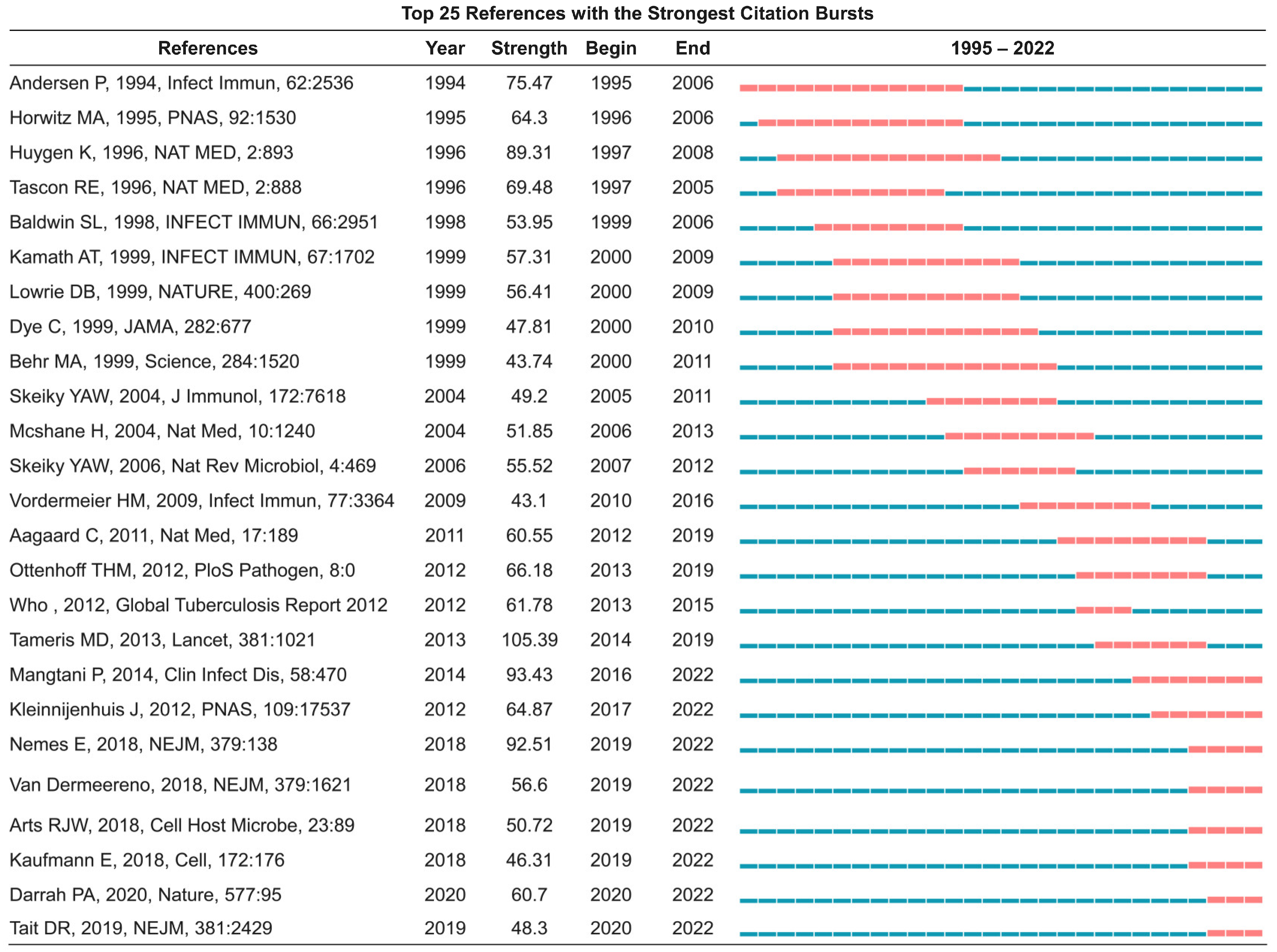A Summary on Tuberculosis Vaccine Development—Where to Go?
Abstract
1. Introduction
2. Materials and Methods
2.1. Data Materials
2.2. Retrieval Strategies
2.3. Data Extraction
2.4. Data Visualization and Analysis
2.5. CiteSpace
2.6. Ethics Statement
2.7. Statistical Analysis
3. Results
3.1. Number of Publication Outputs and Citations over the Years
3.2. Regional and Country Distribution of Studies Related to TB Vaccines
3.3. Institutional Distribution in TB Vaccine Research
3.4. Funding Agencies Distribution in TB Vaccine Development
3.5. Analysis of Journals and Co-Cited Journals
3.6. Distribution of Authors in Publications on TB Vaccines
3.7. Analysis of Reference Cluster
3.8. Analysis of Being Cited Status of TB Vaccine-Related Studies
3.9. Burst References Analysis
3.10. Trend Topics and Thematic Maps Analysis
4. Discussion
5. Conclusions
Supplementary Materials
Author Contributions
Funding
Institutional Review Board Statement
Informed Consent Statement
Data Availability Statement
Acknowledgments
Conflicts of Interest
References
- WHO. Global Tuberculosis Report 2022; World Health Organization: Geneva, Switzerland, 2022. [Google Scholar]
- Gong, W.; Mao, Y.; Li, Y.; Qi, Y. BCG Vaccination: A potential tool against COVID-19 and COVID-19-like Black Swan incidents. Int. Immunopharmacol. 2022, 108, 108870. [Google Scholar] [CrossRef]
- Gong, W.; Liang, Y.; Mi, J.; Xue, Y.; Wang, J.; Wang, L.; Zhou, Y.; Sun, S.; Wu, X. A peptide-based vaccine ACP derived from antigens of Mycobacterium tuberculosis induced Th1 response but failed to enhance the protective efficacy of BCG in mice. Indian J. Tuberc. 2022, 69, 482–495. [Google Scholar] [CrossRef]
- Gong, W.; Liang, Y.; Wu, X. The current status, challenges, and future developments of new tuberculosis vaccines. Hum. Vaccin. Immunother. 2018, 14, 1697–1716. [Google Scholar] [CrossRef]
- Gong, W.; Liang, Y.; Mi, J.; Jia, Z.; Xue, Y.; Wang, J.; Wang, L.; Zhou, Y.; Sun, S.; Wu, X. Peptides-Based Vaccine MP3RT Induced Protective Immunity Against Mycobacterium Tuberculosis Infection in a Humanized Mouse Model. Front. Immunol. 2021, 12, 666290. [Google Scholar] [CrossRef]
- Romano, M.; Squeglia, F.; Kramarska, E.; Barra, G.; Choi, H.G.; Kim, H.J.; Ruggiero, A.; Berisio, R. A Structural View at Vaccine Development against M. tuberculosis. Cells 2023, 12, 317. [Google Scholar] [CrossRef]
- Jones, B.F.; Weinberg, B.A. Age dynamics in scientific creativity. Proc. Natl. Acad. Sci. USA 2011, 108, 18910–18914. [Google Scholar] [CrossRef] [PubMed]
- Zheng, Q.; Xu, J.; Gao, Y.; Liu, M.; Cheng, L.; Xiong, L.; Cheng, J.; Yuan, M.; OuYang, G.; Huang, H.; et al. Past, present and future of living systematic review: A bibliometrics analysis. BMJ Glob. Health 2022, 7, e009378. [Google Scholar] [CrossRef]
- Wang, J.; Zhang, Q.; Wang, H.; Gong, W. The Potential Roles of BCG Vaccine in the Prevention or Treatment of COVID-19. Front. Biosci. (Landmark Ed.) 2022, 27, 157. [Google Scholar] [CrossRef] [PubMed]
- Gong, W.; An, H.; Wang, J.; Cheng, P.; Qi, Y. The Natural Effect of BCG Vaccination on COVID-19: The Debate Continues. Front. Immunol. 2022, 13, 953228. [Google Scholar] [CrossRef] [PubMed]
- Quaia, E.; Vernuccio, F. The H Index Myth: A Form of Fanaticism or a Simple Misconception? Tomography 2022, 8, 1241–1243. [Google Scholar] [CrossRef] [PubMed]
- Costas, R.; Bordons, M. The h-index: Advantages, limitations and its relation with other bibliometric indicators at the micro level. J. Informetr. 2007, 1, 193–203. [Google Scholar] [CrossRef]
- Synnestvedt, M.B.; Chen, C.; Holmes, J.H. CiteSpace II: Visualization and knowledge discovery in bibliographic databases. In AMIA Annual Symposium Proceedings; American Medical Informatics Association: Bethesda, MD, USA, 2005; Volume 2005, pp. 724–728. [Google Scholar]
- Carpenter, C.; Sidney, J.; Kolla, R.; Nayak, K.; Tomiyama, H.; Tomiyama, C.; Padilla, O.A.; Rozot, V.; Ahamed, S.F.; Ponte, C.; et al. A side-by-side comparison of T cell reactivity to fifty-nine Mycobacterium tuberculosis antigens in diverse populations from five continents. Tuberculosis 2015, 95, 713–721. [Google Scholar] [CrossRef] [PubMed]
- Williams, A.; Hatch, G.J.; Clark, S.O.; Gooch, K.E.; Hatch, K.A.; Hall, G.A.; Huygen, K.; Ottenhoff, T.H.; Franken, K.L.; Andersen, P.; et al. Evaluation of vaccines in the EU TB Vaccine Cluster using a guinea pig aerosol infection model of tuberculosis. Tuberculosis 2005, 85, 29–38. [Google Scholar] [CrossRef] [PubMed]
- Khader, S.A.; Divangahi, M.; Hanekom, W.; Hill, P.C.; Maeurer, M.; Makar, K.W.; Mayer-Barber, K.D.; Mhlanga, M.M.; Nemes, E.; Schlesinger, L.S.; et al. Targeting innate immunity for tuberculosis vaccination. J. Clin. Investig. 2019, 129, 3482–3491. [Google Scholar] [CrossRef]
- Colditz, G.A.; Brewer, T.F.; Berkey, C.S.; Wilson, M.E.; Burdick, E.; Fineberg, H.V.; Mosteller, F. Efficacy of BCG vaccine in the prevention of tuberculosis. Meta-analysis of the published literature. JAMA 1994, 271, 698–702. [Google Scholar] [CrossRef]
- Fine, P.E. Variation in protection by BCG: Implications of and for heterologous immunity. Lancet 1995, 346, 1339–1345. [Google Scholar] [CrossRef] [PubMed]
- Cole, S.T.; Brosch, R.; Parkhill, J.; Garnier, T.; Churcher, C.; Harris, D.; Gordon, S.V.; Eiglmeier, K.; Gas, S.; Barry, C.E., 3rd; et al. Deciphering the biology of Mycobacterium tuberculosis from the complete genome sequence. Nature 1998, 393, 537–544. [Google Scholar] [CrossRef]
- Flynn, J.L.; Chan, J. Immunology of tuberculosis. Annu. Rev. Immunol. 2001, 19, 93–129. [Google Scholar] [CrossRef]
- Colditz, G.A.; Berkey, C.S.; Mosteller, F.; Brewer, T.F.; Wilson, M.E.; Burdick, E.; Fineberg, H.V. The efficacy of bacillus Calmette-Guerin vaccination of newborns and infants in the prevention of tuberculosis: Meta-analyses of the published literature. Pediatrics 1995, 96, 29–35. [Google Scholar] [CrossRef]
- Aagaard, C.; Hoang, T.; Dietrich, J.; Cardona, P.J.; Izzo, A.; Dolganov, G.; Schoolnik, G.K.; Cassidy, J.P.; Billeskov, R.; Andersen, P. A multistage tuberculosis vaccine that confers efficient protection before and after exposure. Nat. Med. 2011, 17, 189–194. [Google Scholar] [CrossRef]
- Tameris, M.D.; Hatherill, M.; Landry, B.S.; Scriba, T.J.; Snowden, M.A.; Lockhart, S.; Shea, J.E.; McClain, J.B.; Hussey, G.D.; Hanekom, W.A.; et al. Safety and efficacy of MVA85A, a new tuberculosis vaccine, in infants previously vaccinated with BCG: A randomised, placebo-controlled phase 2b trial. Lancet 2013, 381, 1021–1028. [Google Scholar] [CrossRef]
- Trunz, B.B.; Fine, P.; Dye, C. Effect of BCG vaccination on childhood tuberculous meningitis and miliary tuberculosis worldwide: A meta-analysis and assessment of cost-effectiveness. Lancet 2006, 367, 1173–1180. [Google Scholar] [CrossRef]
- Andersen, P.; Doherty, T.M. The success and failure of BCG—Implications for a novel tuberculosis vaccine. Nat. Rev. Microbiol. 2005, 3, 656–662. [Google Scholar] [CrossRef]
- Concato, J.; Shah, N.; Horwitz, R.I. Randomized, controlled trials, observational studies, and the hierarchy of research designs. N. Engl. J. Med. 2000, 342, 1887–1892. [Google Scholar] [CrossRef]
- Berry, M.P.; Graham, C.M.; McNab, F.W.; Xu, Z.; Bloch, S.A.; Oni, T.; Wilkinson, K.A.; Banchereau, R.; Skinner, J.; Wilkinson, R.J.; et al. An interferon-inducible neutrophil-driven blood transcriptional signature in human tuberculosis. Nature 2010, 466, 973–977. [Google Scholar] [CrossRef] [PubMed]
- Seder, R.A.; Darrah, P.A.; Roederer, M. T-cell quality in memory and protection: Implications for vaccine design. Nat. Rev. Immunol. 2008, 8, 247–258. [Google Scholar] [CrossRef] [PubMed]
- Darrah, P.A.; Patel, D.T.; De Luca, P.M.; Lindsay, R.W.; Davey, D.F.; Flynn, B.J.; Hoff, S.T.; Andersen, P.; Reed, S.G.; Morris, S.L.; et al. Multifunctional TH1 cells define a correlate of vaccine-mediated protection against Leishmania major. Nat. Med. 2007, 13, 843–850. [Google Scholar] [CrossRef] [PubMed]
- Behr, M.A.; Wilson, M.A.; Gill, W.P.; Salamon, H.; Schoolnik, G.K.; Rane, S.; Small, P.M. Comparative genomics of BCG vaccines by whole-genome DNA microarray. Science 1999, 284, 1520–1523. [Google Scholar] [CrossRef] [PubMed]
- Gurunathan, S.; Klinman, D.M.; Seder, R.A. DNA vaccines: Immunology, application, and optimization. Annu. Rev. Immunol. 2000, 18, 927–974. [Google Scholar] [CrossRef] [PubMed]
- van Houwelingen, H.C.; Arends, L.R.; Stijnen, T. Advanced methods in meta-analysis: Multivariate approach and meta-regression. Stat. Med. 2002, 21, 589–624. [Google Scholar] [CrossRef]
- Singh, J.A.; Saag, K.G.; Bridges, S.L., Jr.; Akl, E.A.; Bannuru, R.R.; Sullivan, M.C.; Vaysbrot, E.; McNaughton, C.; Osani, M.; Shmerling, R.H.; et al. 2015 American College of Rheumatology Guideline for the Treatment of Rheumatoid Arthritis. Arthritis Care Res. 2016, 68, 1–25. [Google Scholar] [CrossRef]
- Xu, S.; Xu, D.; Wen, L.; Zhu, C.; Yang, Y.; Han, S.; Guan, P. Integrating Unified Medical Language System and Kleinberg’s Burst Detection Algorithm into Research Topics of Medications for Post-Traumatic Stress Disorder. Drug Des. Dev. Ther. 2020, 14, 3899–3913. [Google Scholar] [CrossRef] [PubMed]
- Andersen, P. Effective vaccination of mice against Mycobacterium tuberculosis infection with a soluble mixture of secreted mycobacterial proteins. Infect. Immun. 1994, 62, 2536–2544. [Google Scholar] [CrossRef] [PubMed]
- Mangtani, P.; Abubakar, I.; Ariti, C.; Beynon, R.; Pimpin, L.; Fine, P.E.; Rodrigues, L.C.; Smith, P.G.; Lipman, M.; Whiting, P.F.; et al. Protection by BCG vaccine against tuberculosis: A systematic review of randomized controlled trials. Clin. Infect. Dis. 2014, 58, 470–480. [Google Scholar] [CrossRef]
- Arts, R.J.W.; Moorlag, S.; Novakovic, B.; Li, Y.; Wang, S.Y.; Oosting, M.; Kumar, V.; Xavier, R.J.; Wijmenga, C.; Joosten, L.A.B.; et al. BCG Vaccination Protects against Experimental Viral Infection in Humans through the Induction of Cytokines Associated with Trained Immunity. Cell Host Microbe. 2018, 23, 89–100.e105. [Google Scholar] [CrossRef] [PubMed]
- Kaufmann, E.; Sanz, J.; Dunn, J.L.; Khan, N.; Mendonca, L.E.; Pacis, A.; Tzelepis, F.; Pernet, E.; Dumaine, A.; Grenier, J.C.; et al. BCG Educates Hematopoietic Stem Cells to Generate Protective Innate Immunity against Tuberculosis. Cell 2018, 172, 176–190. [Google Scholar] [CrossRef] [PubMed]
- Darrah, P.A.; Zeppa, J.J.; Maiello, P.; Hackney, J.A.; Wadsworth, M.H., 2nd; Hughes, T.K.; Pokkali, S.; Swanson, P.A., 2nd; Grant, N.L.; Rodgers, M.A.; et al. Prevention of tuberculosis in macaques after intravenous BCG immunization. Nature 2020, 577, 95–102. [Google Scholar] [CrossRef] [PubMed]
- Nemes, E.; Geldenhuys, H.; Rozot, V.; Rutkowski, K.T.; Ratangee, F.; Bilek, N.; Mabwe, S.; Makhethe, L.; Erasmus, M.; Toefy, A.; et al. Prevention of M. tuberculosis Infection with H4:IC31 Vaccine or BCG Revaccination. N. Engl. J. Med. 2018, 379, 138–149. [Google Scholar] [CrossRef]
- Songane, M.; Kleinnijenhuis, J.; Alisjahbana, B.; Sahiratmadja, E.; Parwati, I.; Oosting, M.; Plantinga, T.S.; Joosten, L.A.; Netea, M.G.; Ottenhoff, T.H.; et al. Polymorphisms in autophagy genes and susceptibility to tuberculosis. PLoS ONE 2012, 7, e41618. [Google Scholar] [CrossRef]
- Van Der Meeren, O.; Hatherill, M.; Nduba, V.; Wilkinson, R.J.; Muyoyeta, M.; Van Brakel, E.; Ayles, H.M.; Henostroza, G.; Thienemann, F.; Scriba, T.J. Phase 2b controlled trial of M72/AS01E vaccine to prevent tuberculosis. N. Engl. J. Med. 2018, 379, 1621–1634. [Google Scholar] [CrossRef]
- Tait, D.R.; Hatherill, M.; Van Der Meeren, O.; Ginsberg, A.M.; Van Brakel, E.; Salaun, B.; Scriba, T.J.; Akite, E.J.; Ayles, H.M.; Bollaerts, A.; et al. Final Analysis of a Trial of M72/AS01(E) Vaccine to Prevent Tuberculosis. N. Engl. J. Med. 2019, 381, 2429–2439. [Google Scholar] [CrossRef]
- Kleinnijenhuis, J.; Quintin, J.; Preijers, F.; Joosten, L.A.; Ifrim, D.C.; Saeed, S.; Jacobs, C.; van Loenhout, J.; de Jong, D.; Stunnenberg, H.G.; et al. Bacille Calmette-Guerin induces NOD2-dependent nonspecific protection from reinfection via epigenetic reprogramming of monocytes. Proc. Natl. Acad. Sci. USA 2012, 109, 17537–17542. [Google Scholar] [CrossRef] [PubMed]
- Aria, M.; Cuccurullo, C.; D’Aniello, L.; Misuraca, M.; Spano, M. Thematic Analysis as a New Culturomic Tool: The Social Media Coverage on COVID-19 Pandemic in Italy. Sustainability 2022, 14, 3643. [Google Scholar] [CrossRef]
- Rodriguez, A.; Laio, A. Machine learning. Clustering by fast search and find of density peaks. Science 2014, 344, 1492–1496. [Google Scholar] [CrossRef] [PubMed]
- Aria, M.; Cuccurullo, C. Bibliometrix: An R-tool for comprehensive science mapping analysis. J. Informetr. 2017, 11, 959–975. [Google Scholar] [CrossRef]
- Su, Y.; Ruan, Z.; Wang, R.; Hao, S.; Tang, Y.; Huang, X.; Gao, T.; Li, Z.; Chang, T. Knowledge mapping of targeted immunotherapy for myasthenia gravis from 1998 to 2022: A bibliometric analysis. Front. Immunol. 2022, 13, 998217. [Google Scholar] [CrossRef]
- Ciulla, T.A.; Hussain, R.M.; Berrocal, A.M.; Nagiel, A. Voretigene neparvovec-rzyl for treatment of RPE65-mediated inherited retinal diseases: A model for ocular gene therapy development. Expert Opin. Biol. Ther. 2020, 20, 565–578. [Google Scholar] [CrossRef]
- Maguire, A.M.; Russell, S.; Chung, D.C.; Yu, Z.F.; Tillman, A.; Drack, A.V.; Simonelli, F.; Leroy, B.P.; Reape, K.Z.; High, K.A.; et al. Durability of Voretigene Neparvovec for Biallelic RPE65-Mediated Inherited Retinal Disease: Phase 3 Results at 3 and 4 Years. Ophthalmology 2021, 128, 1460–1468. [Google Scholar] [CrossRef]
- Russell, S.; Bennett, J.; Wellman, J.A.; Chung, D.C.; Yu, Z.F.; Tillman, A.; Wittes, J.; Pappas, J.; Elci, O.; McCague, S.; et al. Efficacy and safety of voretigene neparvovec (AAV2-hRPE65v2) in patients with RPE65-mediated inherited retinal dystrophy: A randomised, controlled, open-label, phase 3 trial. Lancet 2017, 390, 849–860. [Google Scholar] [CrossRef]
- EMA. New Gene Therapy for Rare Inherited Disorder Causing Vision Loss Recommended for Approval. Available online: https://www.ema.europa.eu/en/news/new-gene-therapy-rare-inherited-disorder-causing-vision-loss-recommended-approval (accessed on 25 October 2022).
- Adli, M. The CRISPR tool kit for genome editing and beyond. Nat. Commun. 2018, 9, 1911. [Google Scholar] [CrossRef]
- Li, S.Y.; Cheng, Q.X.; Liu, J.K.; Nie, X.Q.; Zhao, G.P.; Wang, J. CRISPR-Cas12a has both cis- and trans-cleavage activities on single-stranded DNA. Cell Res. 2018, 28, 491–493. [Google Scholar] [CrossRef] [PubMed]
- Terns, M.P. CRISPR-Based Technologies: Impact of RNA-Targeting Systems. Mol. Cell 2018, 72, 404–412. [Google Scholar] [CrossRef] [PubMed]
- Dunbar, C.E.; High, K.A.; Joung, J.K.; Kohn, D.B.; Ozawa, K.; Sadelain, M. Gene therapy comes of age. Science 2018, 359, eaan4672. [Google Scholar] [CrossRef] [PubMed]
- Smith, D.R. The historical development of academic journals in occupational medicine, 1901–2009. Arch. Environ. Occup. Health 2009, 64 (Suppl. S1), 8–17. [Google Scholar] [CrossRef] [PubMed][Green Version]
- Olusanya, B.O.; Mallewa, M.; Ogbo, F.A. Beyond pledges: Academic journals in high-income countries can do more to decolonise global health. BMJ Glob. Health 2021, 6, e006200. [Google Scholar] [CrossRef] [PubMed]
- Lim Ban, S.; Willett, P. The citedness of publications by United Kingdom library schools. J. Inf. Sci. 2016, 21, 68–71. [Google Scholar] [CrossRef]
- Cohn, E.G.; Farrington, D.P.; Sorensen, J.R. Journal publications of Ph.D. graduates from American criminology and criminal justice programs. J. Crim. Justice Educ. 2000, 11, 35–49. [Google Scholar] [CrossRef]
- Ebrahim, N.A.; Salehi, H.; Embi, M.A.; Tanha, F.H.; Gholizadeh, H.; Motahar, S.M. Visibility and Citation Impact. Int. Educ. Stud. 2014, 7, 120–125. [Google Scholar] [CrossRef]
- Fontelo, P.; Liu, F. A review of recent publication trends from top publishing countries. Syst. Rev. 2018, 7, 147. [Google Scholar] [CrossRef]
- Cardador, M.T.; Hazan, A.R.; Glantz, S.A. Tobacco industry smokers’ rights publications: A content analysis. Am. J. Public Health 1995, 85, 1212–1217. [Google Scholar] [CrossRef]
- Moser, P.L.; Hauffe, H.; Lorenz, I.H.; Hager, M.; Tiefenthaler, W.; Lorenz, H.M.; Mikuz, G.; Soegner, P.; Kolbitsch, C. Publication output in telemedicine during the period January 1964 to July 2003. J. Telemed. Telecare. 2004, 10, 72–77. [Google Scholar] [CrossRef]
- Minasny, B.; Hartemink, A.E.; McBratney, A.; Jang, H.J. Citations and the h index of soil researchers and journals in the Web of Science, Scopus, and Google Scholar. PeerJ 2013, 1, e183. [Google Scholar] [CrossRef] [PubMed]
- Liu, P.C.; Lu, Y.; Lin, H.H.; Yao, Y.C.; Wang, S.T.; Chang, M.C.; Chien, T.W.; Chou, P.H. Classification and citation analysis of the 100 top-cited articles on adult spinal deformity since 2011: A bibliometric analysis. J. Chin. Med. Assoc. 2022, 85, 401–408. [Google Scholar] [CrossRef]
- De Stefano, F.A.; Kaura, S.; Hankey, P.B.; Dharia, A.; Heskett, C.; Peterson, J.; Ebersole, K. A Bibliometric Analysis of the Top 100 Most Influential Articles on Carotid Cavernous Fistulas. World Neurosurg. 2022, 167, 44–54. [Google Scholar] [CrossRef] [PubMed]
- Seu, M.Y.; Yang, S.D.; Qiao, J.B.; Hansdorfer, M.A.; Graham, S.; Wiegmann, A.; Esmaeeli, S.; Dorafshar, A.H. The Association Between H-Index and Publication of Plastic Surgery Meeting Presenters From 2014 to 2017. J. Surg. Res. 2022, 272, 125–131. [Google Scholar] [CrossRef]
- Kamath, S.D.; Fought, A.J.; Shaw, M.M.; Davis, A.A. Association of Financial Conflicts of Interest with Academic Productivity Among Junior Faculty in Hematology and Oncology. Oncology 2022, 36, 84–91. [Google Scholar] [CrossRef] [PubMed]
- Ammann, A.M.; Delman, A.M.; Bethi, M.; Turner, K.M.; Sedaghat, A.R.; Holm, T.M. Gender Disparities in Academic Productivity and Promotion Among Endocrine Surgery Faculty. J. Surg. Res. 2022, 277, 335–341. [Google Scholar] [CrossRef]
- Patel, P.A.; Patel, P.N.; Ahmed, H.; Forouzan, P. An Analysis of Ophthalmic Plastic and Reconstructive Surgery Fellowship Program Directors in the United States. Cureus 2022, 14, e26268. [Google Scholar] [CrossRef]
- Chen, L.; Lou, Z.; Fang, Y.; Pan, L.; Zhao, J.; Zeng, Y.; Wang, Y.; Wang, N.; Ruan, B. Use of the bibliometric in rare diseases: Taking Wilson disease personally. Orphanet. J. Rare Dis. 2022, 17, 297. [Google Scholar] [CrossRef] [PubMed]
- Reverter Masia, J.; Hernandez Gonzalez, V.; Jove Deltell, C.; Fonseca, T.d.J.; Legaz-Arrese, A. WoS scientific education and the H-index of hirchs in the area of Physical Education in Spain and Brazil: Productivity and comparison between countries. Movimento 2013, 19, 125–147. [Google Scholar]
- Montazerian, M.; Zanotto, E.D.; Eckert, H. A new parameter for (normalized) evaluation of H-index: Countries as a case study. Scientometrics 2019, 118, 1065–1078. [Google Scholar] [CrossRef]
- Meo, S.A.; Al Masri, A.A.; Usmani, A.M.; Memon, A.N.; Zaidi, S.Z. Impact of GDP, spending on R&D, number of universities and scientific journals on research publications among Asian countries. PLoS ONE 2013, 8, e66449. [Google Scholar] [CrossRef]
- Jacsó, P. The h-index for countries in Web of Science and Scopus. Online Inf. Rev. 2009, 33, 831–837. [Google Scholar] [CrossRef]
- Romero, A.H.; García, A.; Kiwi, M. Evaluation of the scientific impact, productivity and biological age based upon the h-index in three Latin American countries: The materials science case. Annalen der Physik 2009, 18, 198–205. [Google Scholar] [CrossRef]
- Berthold, F.; Bartenhagen, C.; Krempel, L. Are network growth and the contributions to congresses associated with publication success? A pediatric oncology model. PLoS ONE 2019, 14, e0210994. [Google Scholar] [CrossRef] [PubMed]
- Pagel, P.S.; Hudetz, J.A. An analysis of scholarly productivity in United States academic anaesthesiologists by citation bibliometrics. Anaesthesia 2011, 66, 873–878. [Google Scholar] [CrossRef] [PubMed]

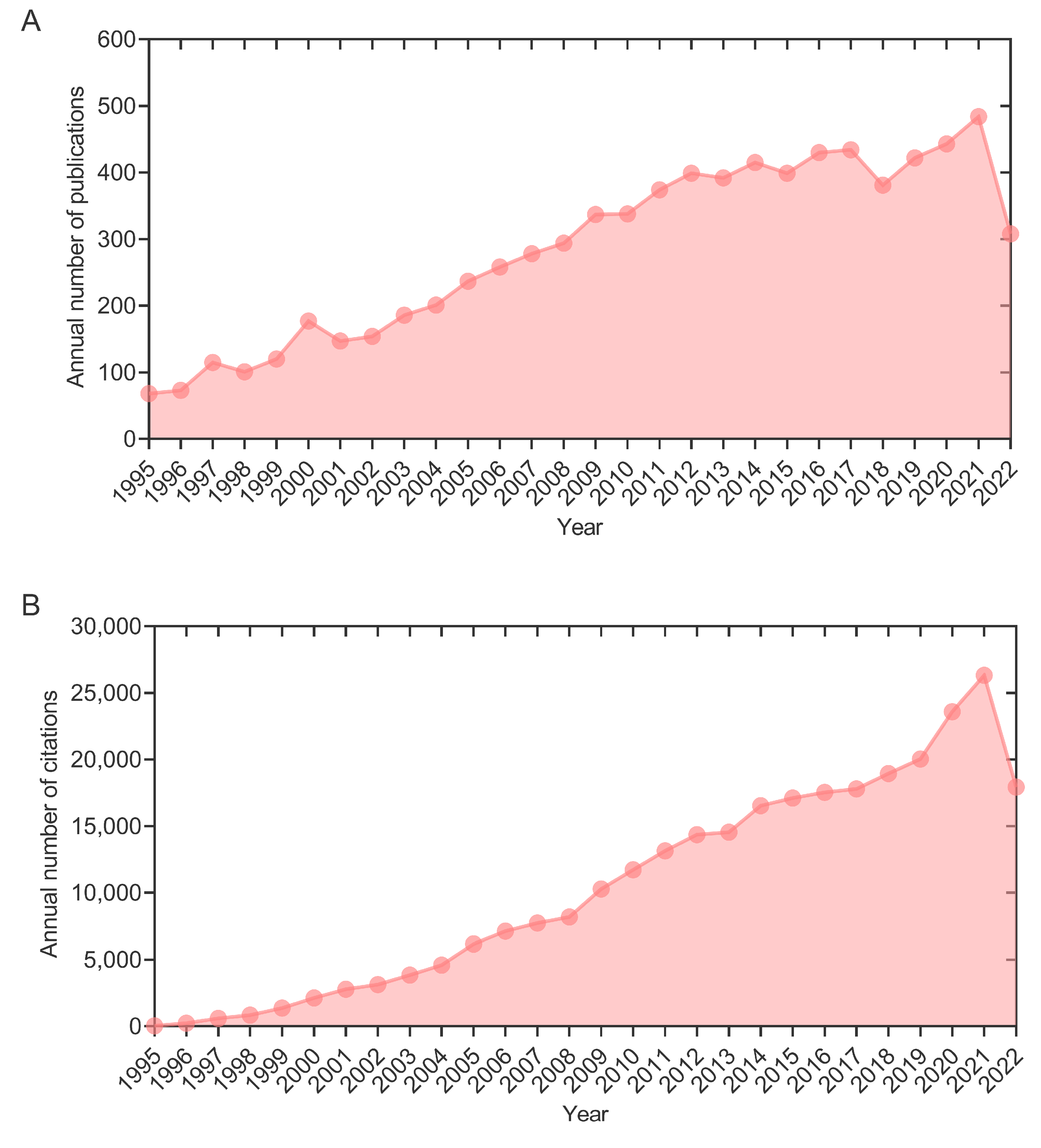
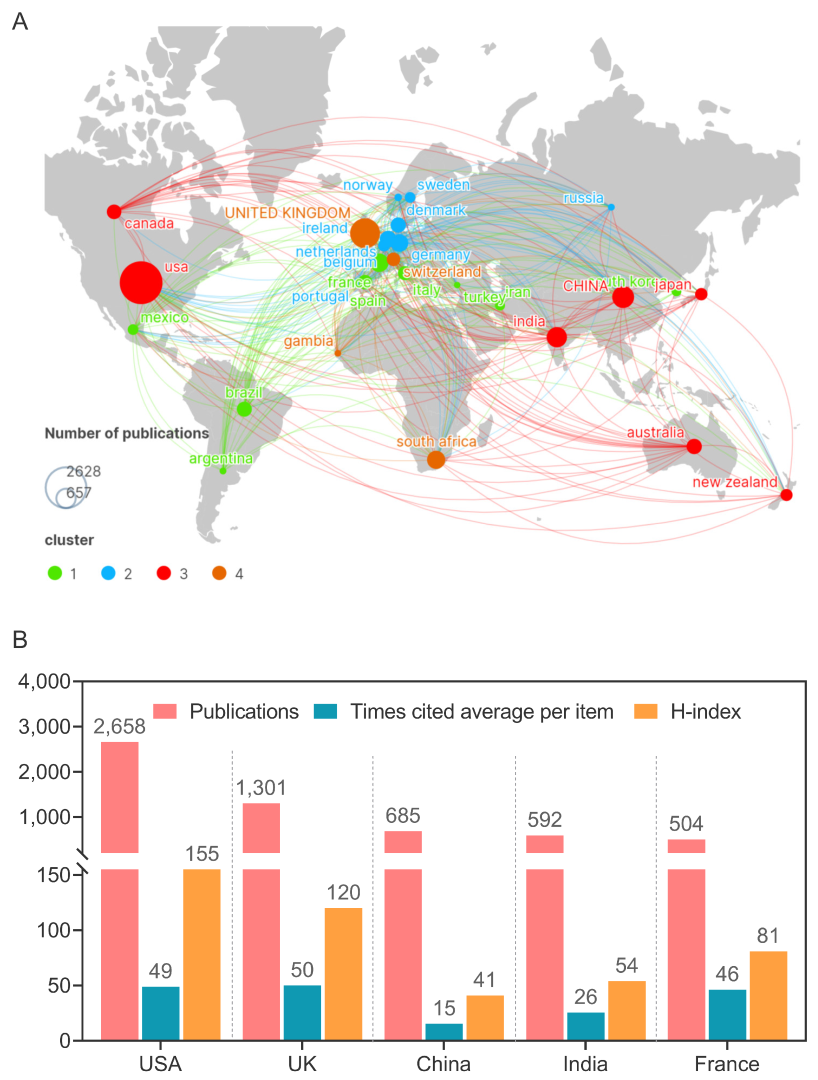
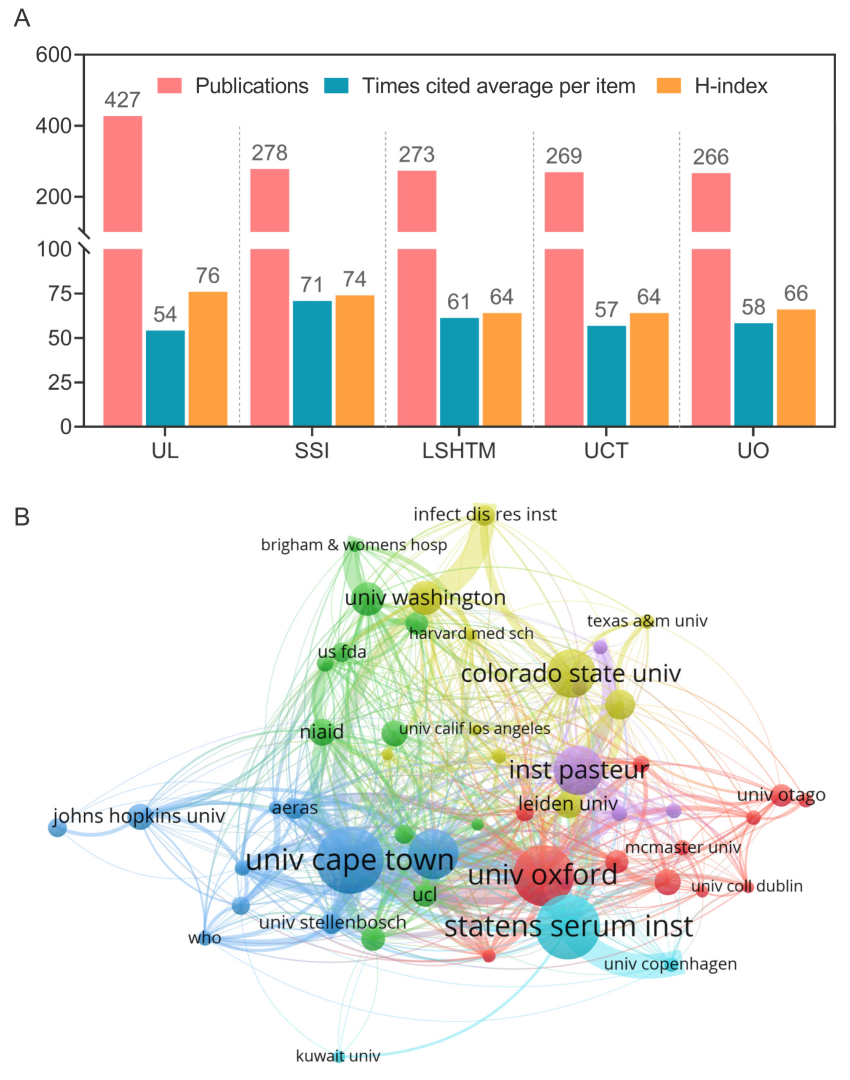
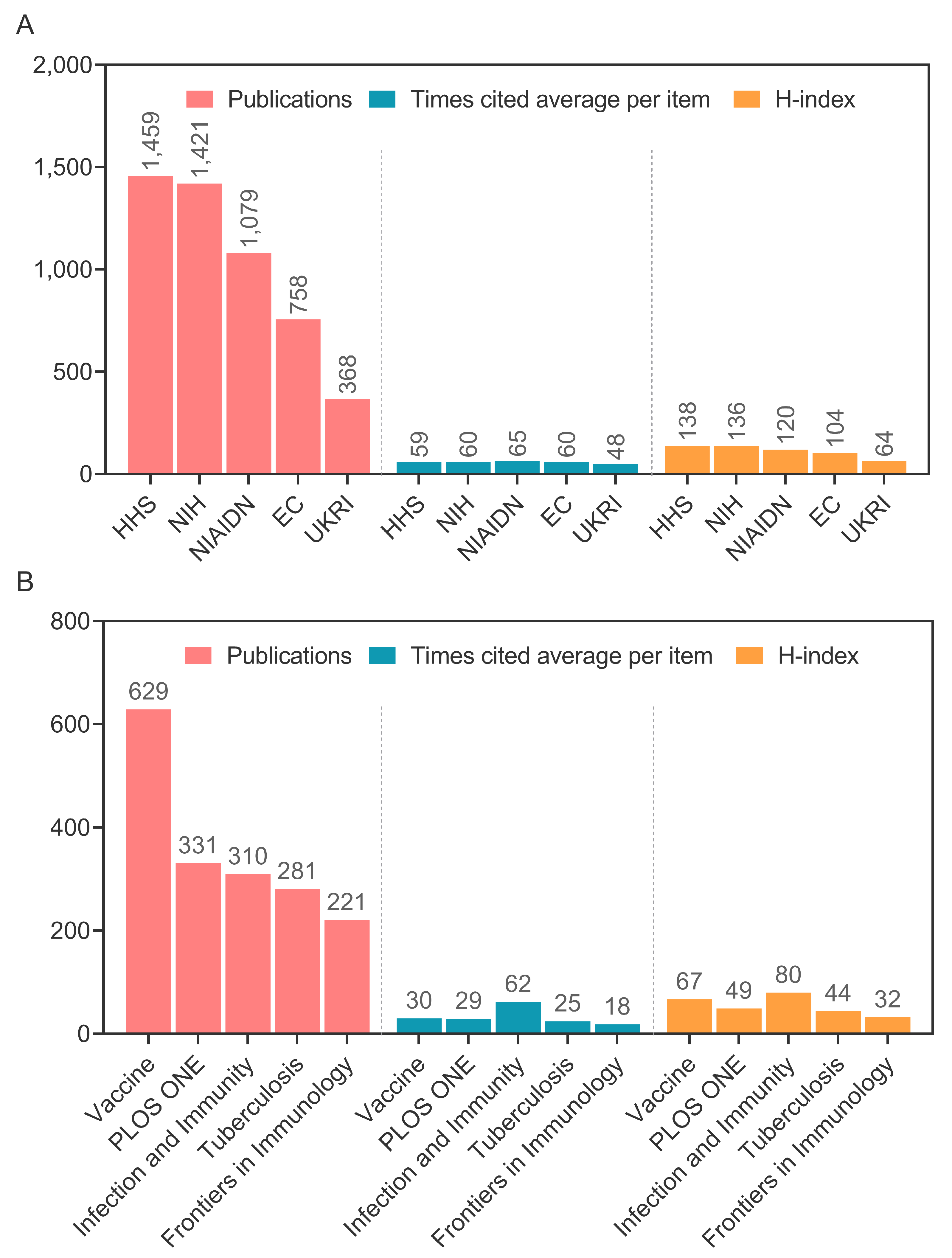
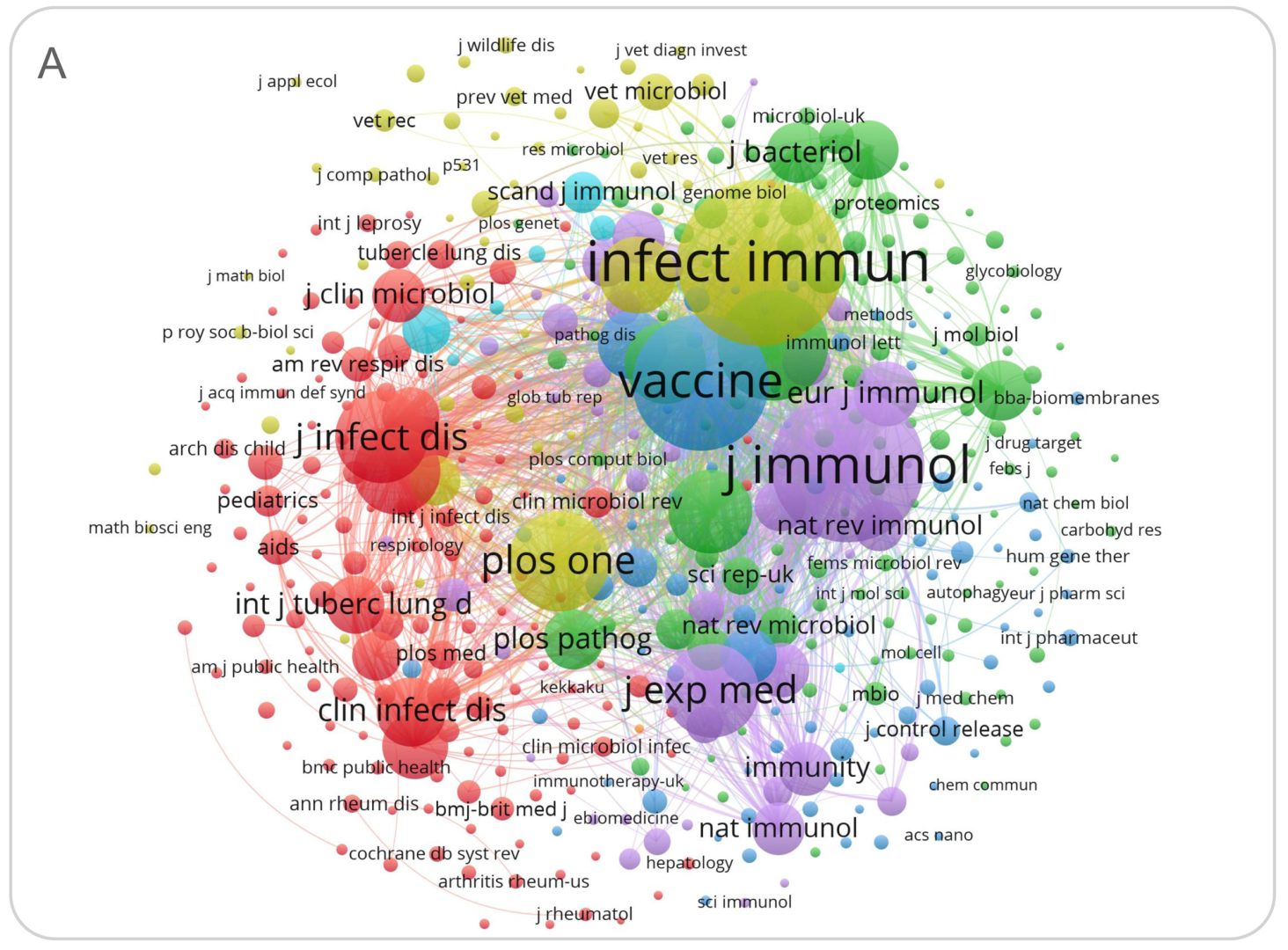

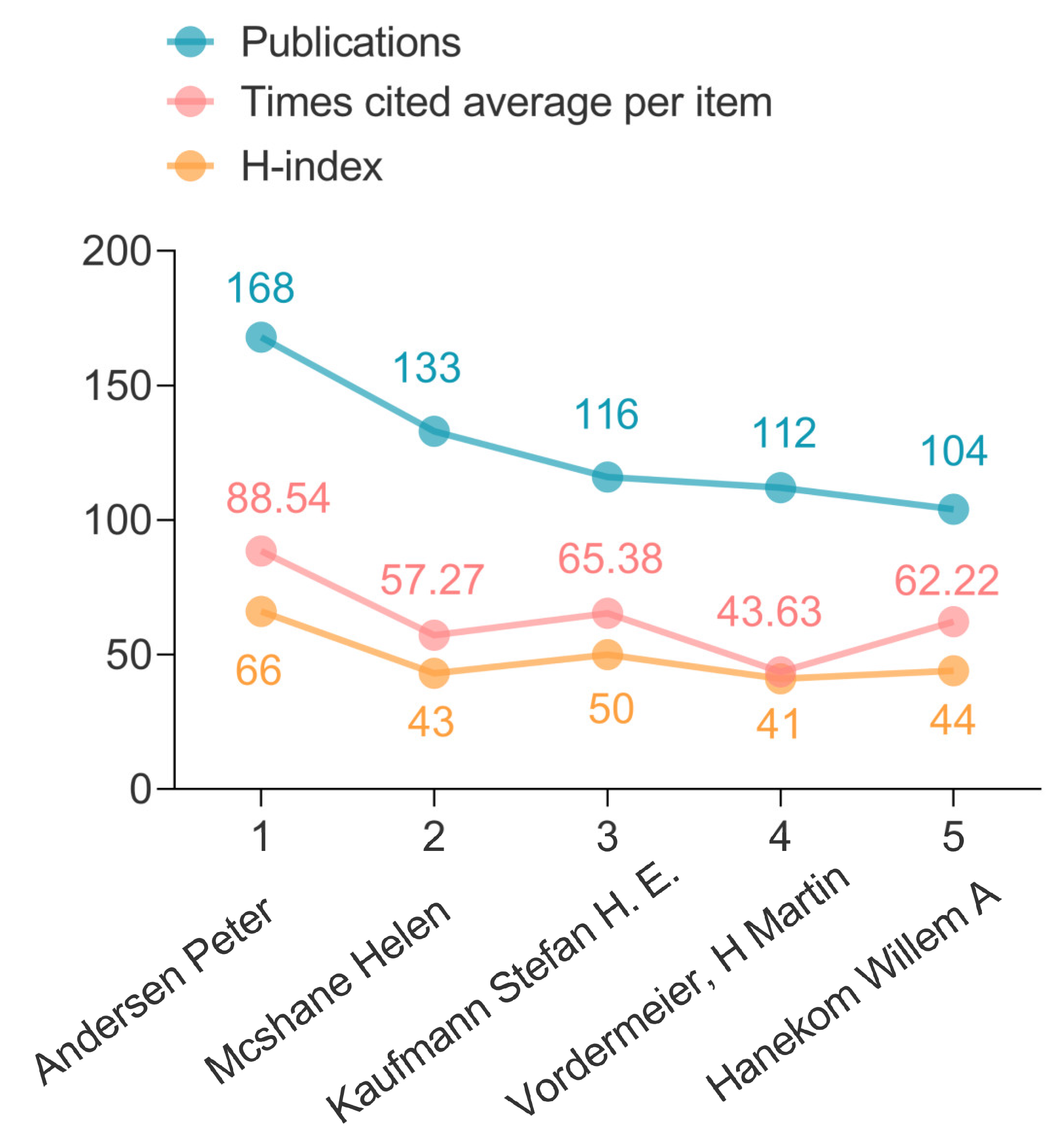
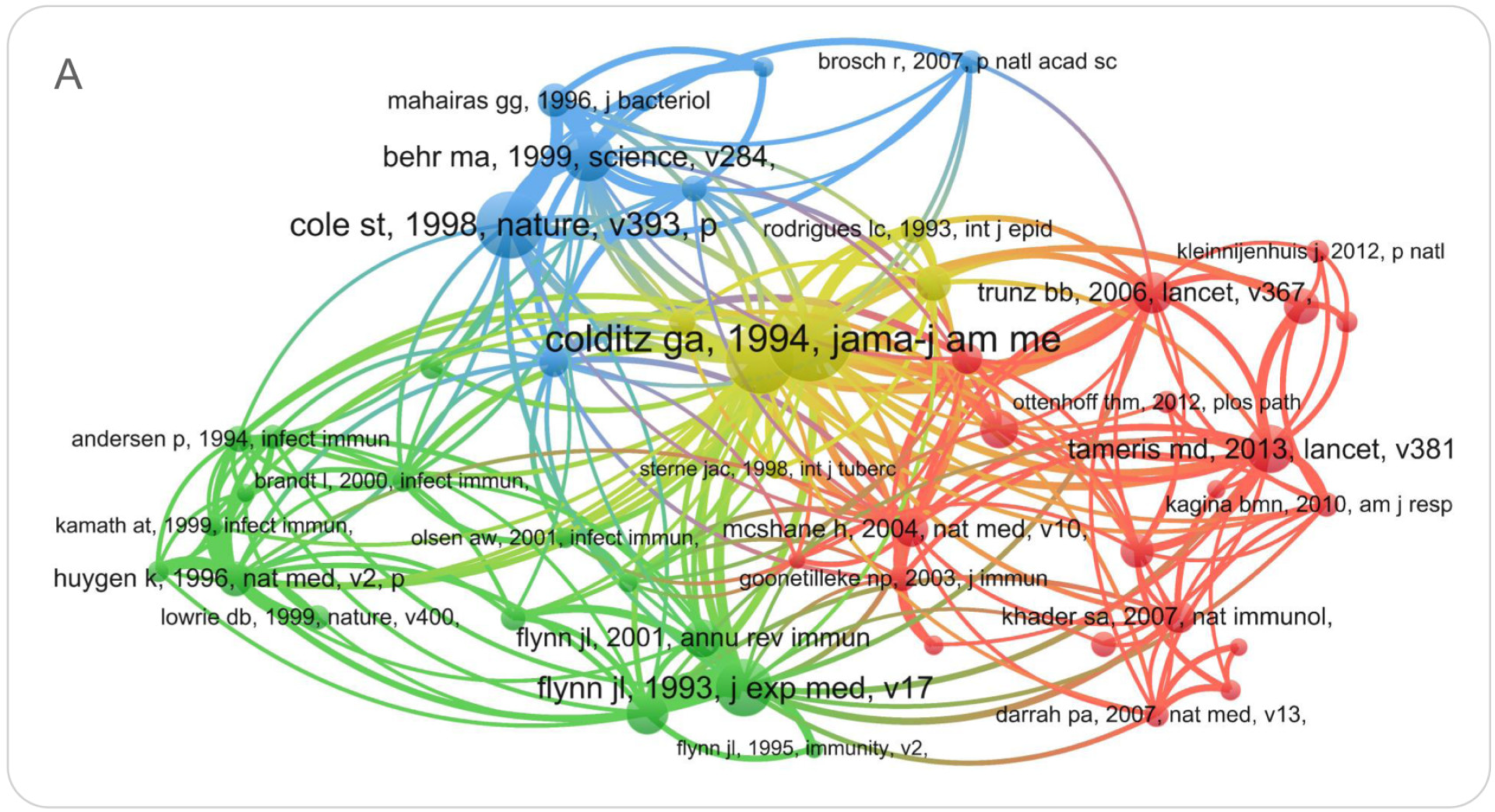
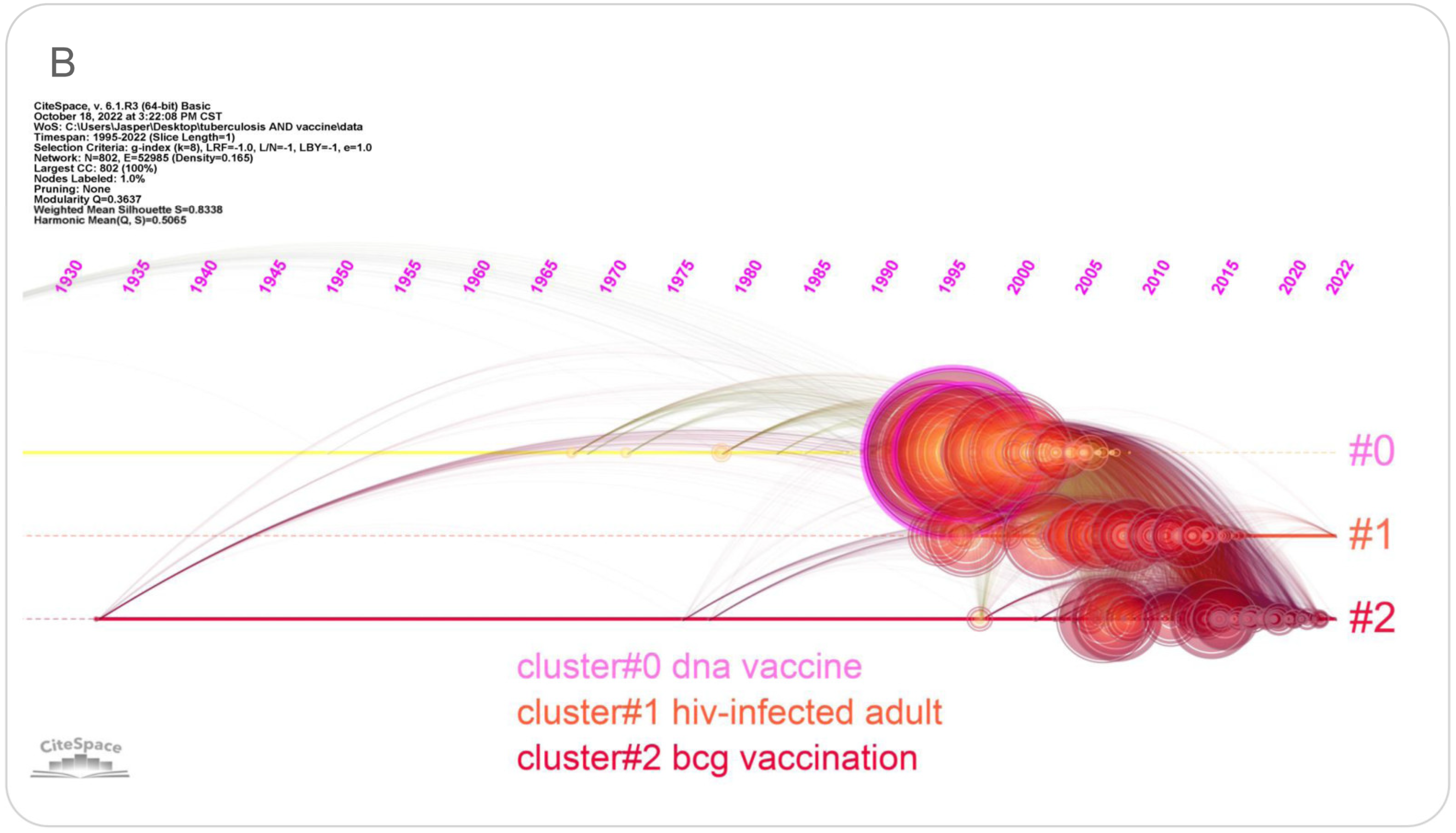
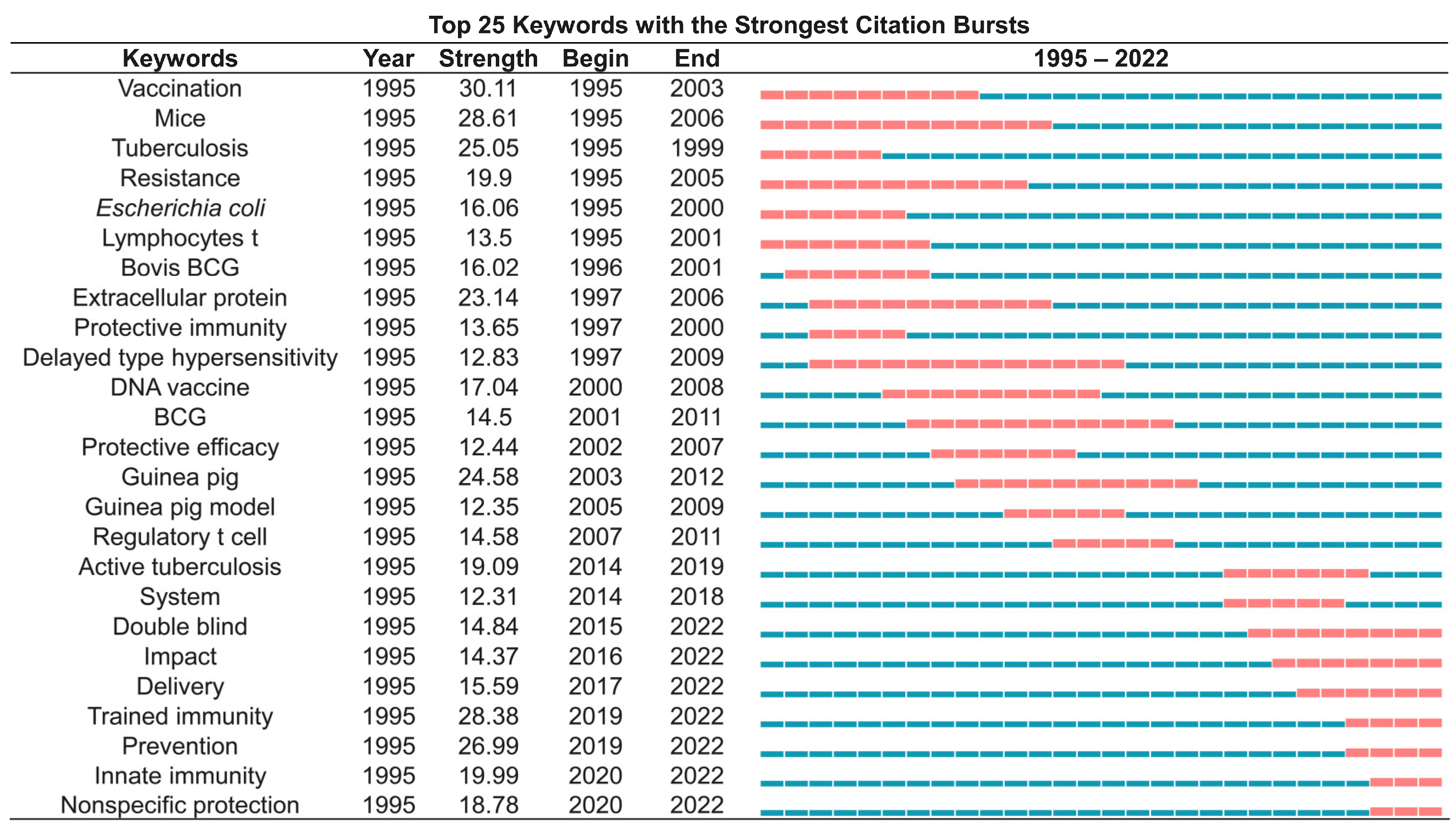
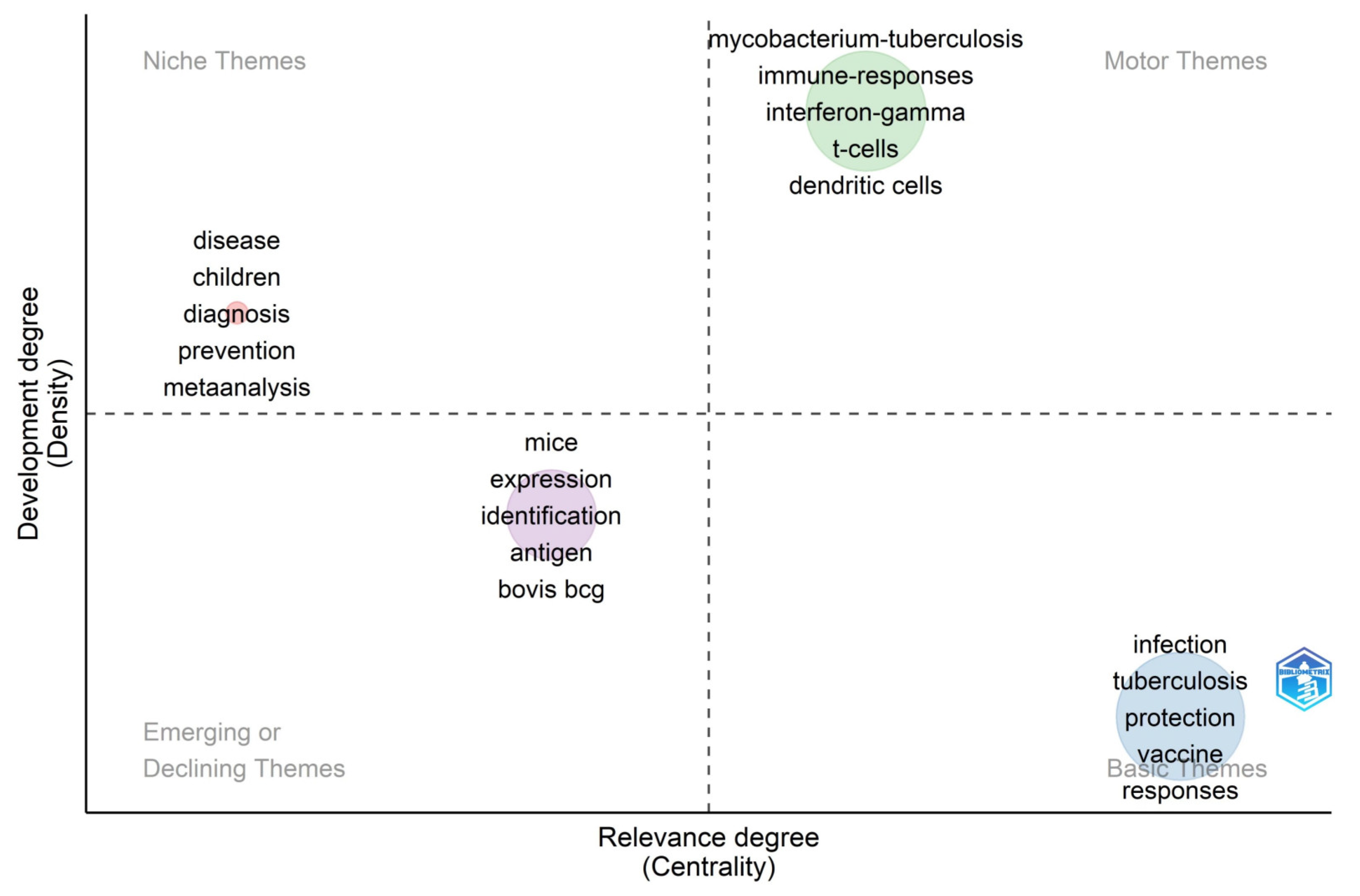
| Publications | Centrality a | Institution | Year | Half-life b | Cluster ID c |
|---|---|---|---|---|---|
| 251 | 0.13 | UCT | 2005 | 9.5 | 0 |
| 185 | 0.13 | LSHTM | 1998 | 18.5 | 0 |
| 236 | 0.12 | UO | 1998 | 15.5 | 4 |
| 246 | 0.12 | SSI | 1998 | 14.5 | 1 |
| 172 | 0.1 | IP | 1998 | 7.5 | 1 |
| 184 | 0.09 | CSU | 1998 | 12.5 | 3 |
| 81 | 0.06 | UM | 2009 | 7.5 | 2 |
| 91 | 0.06 | NIAID | 1998 | 16.5 | 2 |
| 75 | 0.05 | UCL | 1998 | 16.5 | 5 |
| 84 | 0.05 | JHU | 1999 | 13.5 | 0 |
| Rank | Reference | Publish Time | 2018 | 2019 | 2020 | 2021 | 2022 | Average per Year | Total |
|---|---|---|---|---|---|---|---|---|---|
| 1 | [26] | Jun 2000 | 97 | 102 | 102 | 99 | 60 | 100.22 | 2305 |
| 2 | [20] | 2001 | 43 | 37 | 40 | 45 | 32 | 74.27 | 1634 |
| 3 | [27] | Aug 2010 | 127 | 104 | 99 | 112 | 56 | 93.92 | 1221 |
| 4 | [30] | May 1999 | 23 | 25 | 18 | 22 | 14 | 49.5 | 1188 |
| 5 | [33] | Jan 2016 | 280 | 273 | 180 | 166 | 87 | 172.43 | 1207 |
| 6 | [28] | Apr 2008 | 68 | 55 | 55 | 64 | 49 | 75.07 | 1126 |
| 7 | [32] | Feb 2002 | 65 | 68 | 60 | 65 | 40 | 53.57 | 1125 |
| 8 | [29] | Jul 2007 | 52 | 55 | 49 | 51 | 16 | 64.31 | 1029 |
| 9 | [18] | Nov 1995 | 30 | 32 | 39 | 46 | 16 | 35.93 | 1006 |
| 10 | [31] | 2000 | 21 | 12 | 14 | 11 | 5 | 41.39 | 952 |
| Accumulation | 10 Publications | 806 | 763 | 656 | 681 | 375 | 760.61 | 12,793 | |
| Total | 7960 Publications | 18,944 | 20,042 | 23,584 | 26,323 | 17,733 | 10,302.79 | 288,478 | |
| Ratio | 0.125% | 4.25% | 3.81% | 2.78% | 2.59% | 2.11% | 7.38% | 4.43% | |
Disclaimer/Publisher’s Note: The statements, opinions and data contained in all publications are solely those of the individual author(s) and contributor(s) and not of MDPI and/or the editor(s). MDPI and/or the editor(s) disclaim responsibility for any injury to people or property resulting from any ideas, methods, instructions or products referred to in the content. |
© 2023 by the authors. Licensee MDPI, Basel, Switzerland. This article is an open access article distributed under the terms and conditions of the Creative Commons Attribution (CC BY) license (https://creativecommons.org/licenses/by/4.0/).
Share and Cite
Jiang, F.; Sun, T.; Cheng, P.; Wang, J.; Gong, W. A Summary on Tuberculosis Vaccine Development—Where to Go? J. Pers. Med. 2023, 13, 408. https://doi.org/10.3390/jpm13030408
Jiang F, Sun T, Cheng P, Wang J, Gong W. A Summary on Tuberculosis Vaccine Development—Where to Go? Journal of Personalized Medicine. 2023; 13(3):408. https://doi.org/10.3390/jpm13030408
Chicago/Turabian StyleJiang, Fan, Tiehui Sun, Peng Cheng, Jie Wang, and Wenping Gong. 2023. "A Summary on Tuberculosis Vaccine Development—Where to Go?" Journal of Personalized Medicine 13, no. 3: 408. https://doi.org/10.3390/jpm13030408
APA StyleJiang, F., Sun, T., Cheng, P., Wang, J., & Gong, W. (2023). A Summary on Tuberculosis Vaccine Development—Where to Go? Journal of Personalized Medicine, 13(3), 408. https://doi.org/10.3390/jpm13030408







